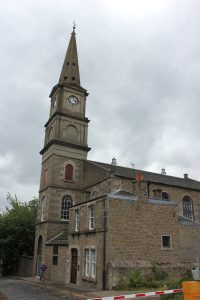Angus
Dundee
Dundee is a busy port city, whose industries were once summed up as jam, jute and journalism, the last relating to the publishers of the children's comic Beano. It also has a long tradition of shipbuilding and hosts the retired Royal Yacht Britannia as a tourist attraction.

Mary Slessor memorial
There are associations with the protestant reformer and martyr George Wishart (1513-1546), the preacher and revival leader Robert Murray M'Cheyne (1813-1843) and the missionary Mary Slessor (1848-1915).
The main art gallery and museum of Dundee is the McManus in Albert Square (DD1 1DA), which has a cabinet devoted to the work of Mary Slessor. The exhibits include personal possessions and photographs, as well as her Bible and diary. There are also some African artefacts, collected during her 40 years in the Calabar region of Nigeria.
Outside the misnamed Steeple Church in Nethergate (there is no steeple) is a memorial to Mary Slessor, consisting of a large piece of granite, inset with a relief portrait (DD1 4DG). It was installed in 2015 to mark the centenary of her death. The inscription describes her as weaver, teacher, missionary, magistrate. Born in Aberdeen, she began work, as little more than a child, in one of the city's textile mills. Travelling to Calabar at the age of 28, she laboured for 40 years in that region, sometimes referred to as the white man's grave. She is remembered for challenging the superstitions of local tribes, particularly in relation to the birth of twins, which were assumed to be the work of evil spirits.

Wishart's Arch
Looking a bit forlorn among the offices, flats and hotels of modern Dundee, is a remnant of the old city wall known as Wishart's Arch (DD1 2JA). The name refers to George Wishart, the Scottish reformer who was burned at the stake in St Andrews in 1546 on the orders of Cardinal David Beaton. This triggered a violent response when supporters of the Reformation broke into St Andrews Castle and slew Beaton. Wishart's reputation for courage and dedication had already been established in Dundee, when he remained preaching and ministering to the poor during an outbreak of the plague while most others had fled. The inscription here records that during the plague of 1544, George Wishart preached from the parapet of this port to the people standing within the gate and the plague-stricken lying without in booths.

St Peter's Church
Alongside the arch is a terrace of buildings used either for retail or as part of the large Hotel Indigo behind. At the east end of the terrace a name above the doorway identifies one building as the former Wishart Church. It was to this church that the young Mary Slessor belonged while growing up in the city.
Just off the Perth Road as you leave the city to the west, is St Peter's Church, scene of the ministry of the saintly Robert Murray M'Cheyne. Born and Educated in Edinburgh, M'Cheyne served here from 1836 until his death from typhus at the tragically early age of 29. A notice tells us that he was the first minister of this congregation. The church is largely unchanged from M'Cheyne's time and he is buried in the churchyard, but unfortunately access outside service times is not normally available. During his lifetime there was a growing interest in preaching the gospel to the Jews, and M'Cheyne went on an expedition to Palestine with his friend Andrew Bonar to investigate the possibility of starting a Jewish mission
Arbirlot

Arbirlot parish church
This small community saw the opening years of the ministry of Thomas Guthrie (1803-1873), later to become famous as one of the leaders of the Great Disruption and the formation of the Free Church of Scotland.
Born in Brechin, Guthrie studied medicine at Edinburgh, before transferring to theology. Known as a strong evangelical, he found it hard at first to find a parish. In 1830, he was offered the living of Arbirlot by a local patron - ironically in retrospect as the Disruption was principally about congregations being able to choose their own ministers. He served for seven years before moving to Edinburgh as minister of Old Greyfriars Church. His medical skills were put to good use when there was an outbreak of cholera in the parish during his ministry.


